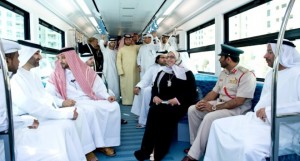As part of a plan to reduce gridlock while attracting tourists, a new monorail in the emirate of Dubai silently whisks passengers to exclusive resorts and offers sweeping ocean views along the way, proving that even public transportation is more extreme in the United Arab Emirates.
 The newly inaugurated and aptly-named Palm Monorail connects the mainland of Dubai to the sun-drenched sands of the artificial palm-shaped island of Palm Jumeirah. On April 30, passengers began paying 15 UAE dirhams (roughly $4) for a one-way ticket between two newly finished stations — one at the Atlantis resort, another at the Gateway Towers.
The newly inaugurated and aptly-named Palm Monorail connects the mainland of Dubai to the sun-drenched sands of the artificial palm-shaped island of Palm Jumeirah. On April 30, passengers began paying 15 UAE dirhams (roughly $4) for a one-way ticket between two newly finished stations — one at the Atlantis resort, another at the Gateway Towers.
If your idea of a monorail involves mouse ears and breakfast with Goofy, or even the Space Needle on a rainy day, think again: riders of the Palm Monorail get aerial views of the unfurling fronds of Palm Jumeirah while traveling over nothing but clear blue water for more than a half mile.
The Palm Monorail is the first of its kind in the Middle East, and was built on land owned by real estate giant Nakheel. The trains, made by Hitachi, run on rails built up and down the “trunk” of the island, with more than 3,600 feet of rail spanning an open waterway.
“We chose it because accident reports indicated it was the safest means of travel, it is safe and sustainable, and it also offers a wonderful opportunity for tourism,” Nakheel executive director told Italian press agency ANSA. According to a press release, the monorail’s relative silence compared to other forms of public transportation also made it an attractive option for nearby resorts and residences.
Stops are planned for the Palm Mall and Trump Tower, in addition to a connection to the Dubai Metro Red Line. Whether any of those stops are built depend on the world economy — ANSA says construction on the stops will resume when the real estate market in surrounding areas picks up again.
Currently, the trains run four times hourly and can carry up to 2,400 passengers each hour, but capacity will increase to 6,000 per hour when the connection to the Dubai Metro is complete and trains are running nine times each hour.
Photos: Nakheel, www.wired.com
















